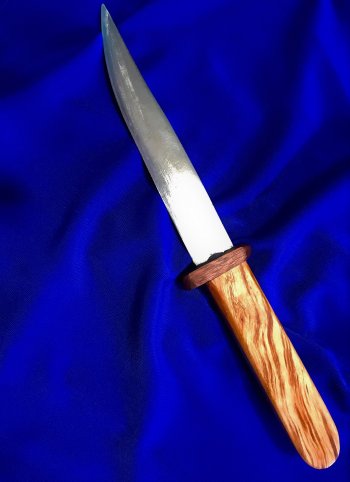Hidden tangs are my specialty! I will try to add what I can, to what's already been said. First, block size is very important, you will eventually come to your own desired size, based on the type of handles you want to produce. That beings said.....remember.....you can take material off...but if you don't start with a large enough block....you can't add any more.
Cutting the EXACT angle to the front of the block, as the guard in paramount. I fit the guard (still in "block" form, finish off it's face, and install it for the final time onto the tang/blade. I actually use the back of the guard, laid on the block, with the tang positioned as I want it to lay inside the block, then, using the back of the guard as a straight edge....draw a line.
I purchased a 10" Ryobi miter saw with a laser guide for the sole purpose of cutting the front angle of hidden tang blocks. Put the block on the saw, and then with the saw running, I torque the table's roatation to where the laser matches the line on the block....then a slow cut, and keep the saw down while you let off the trigger, and allow the saw to fully stop before raising it! Otherwise the blade can catch and splinter the edges of the block.
I mark the center of the front end of the block, and then make a line for the top and bottom of the tang's width. I looks like... |---| on the face of the block.
I like to use a 6" long X 1/4" bit that I have reground to a 135 degree split point (because I use mostly exotics like Blackwood, Ironwood, etc.) I lock the handle block vertically in a vise, compare the length of the bit with the tang I drew on the block for depth....and mark the bit for depth with a sharpie...... and drill two holes..... that intersect down in the block. One hole is ... |*----| and the other is at |----*|
(* = where the holes are started on the face of the block)
I use battery powered drills (like mikita or Ridgid 18V) I "pull" the bit from one hole to the other to open up the "web" between the holes. Then, if needed, use handle broaches to finish fitting.
Something very important..... make sure you have some "slop" in the fit, and for heavens sake, unless it is a through tang, which will have a buttcap/butt nut installed, DO NOT try to "burn in" or make the fit too tight! With a simple hidden tang, no butt cap, it's essential to leave some room for "glue".
I "glue" everything up as finished blade with front of guard material finished, and the guard, spacers, handle all in block form. (like the pic at the top) After "glue" is cured...everything is ground down as a unit.
PITFALLS:
1. When making the tang.... use 3/4 - 1/4 rule for the tang......






